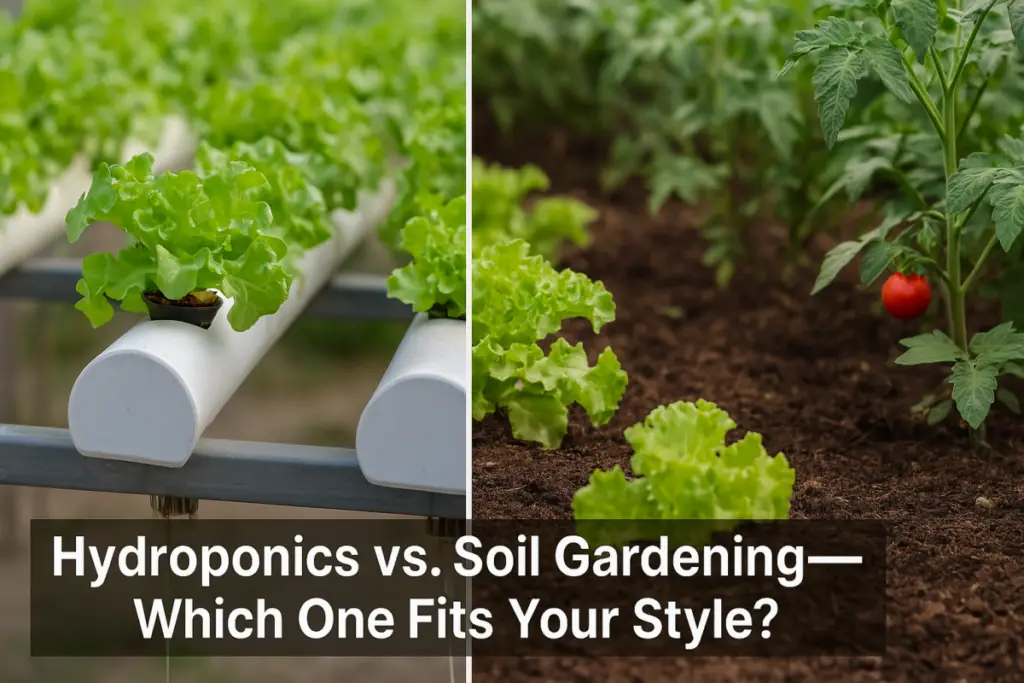
You’ve probably heard the buzz around hydroponic gardening—growing plants without soil sounds futuristic, right? But then, there’s the good old traditional soil gardening, with its earthy smell and satisfying feel of dirt under your nails. So, which one’s better? Spoiler alert: it totally depends on what you’re looking for!
If you’re anything like us, you just want healthy, happy plants without a ton of hassle. Whether you’re into growing fresh herbs in a small urban space or cultivating a backyard full of tomatoes, making the right choice between hydroponics and soil gardening can feel a bit overwhelming.But don’t worry—we’re breaking it down for you in plain, no-nonsense terms. In this guide, we’ll compare the two growing methods side by side, looking at growth rates, taste differences, costs, environmental impact, and more. By the end, you’ll know exactly which method fits your lifestyle and gardening goals.
Let’s dig in!
What’s the Real Difference Between Hydroponics and Soil Gardening?
Alright, let’s kick things off by getting clear on what these two methods actually involve.
Hydroponics: A Quick Overview
- What it is: Growing plants without soil by using a nutrient-rich water solution.
- How it works: Roots are suspended in water or another medium (like clay pellets), absorbing nutrients directly.
- Why people love it: Faster growth, space efficiency, and no soil mess.
Soil Gardening: A Quick Overview
- What it is: The traditional way of growing plants in the ground or in containers filled with soil.
- How it works: Plants draw nutrients from the soil, which can be naturally rich or amended with compost and fertilizers.
Why people love it:Low startup costs, natural process, and it just feels right.
Growth Rates and Yields: Which One Delivers More?
Let’s be honest—when it comes to gardening, we’re all a little impatient. Who doesn’t want faster growth and more produce?
Why Hydroponics Often Wins in Speed
- Direct nutrient access: Plants don’t have to “search” for nutrients, which means they can grow up to 50% faster.
- Controlled environment: Temperature, light, and pH are managed, reducing stress on plants.
- Year-round growing: No waiting for spring—just set up indoors or in a greenhouse.
But Soil Still Has Its Strengths
- Nutrient diversity: Soil naturally contains a mix of minerals and beneficial microbes.
- Stronger root systems: Plants grown in soil often develop more robust root structures.
Less maintenance: Once established, soil gardens usually need less day-to-day attention.
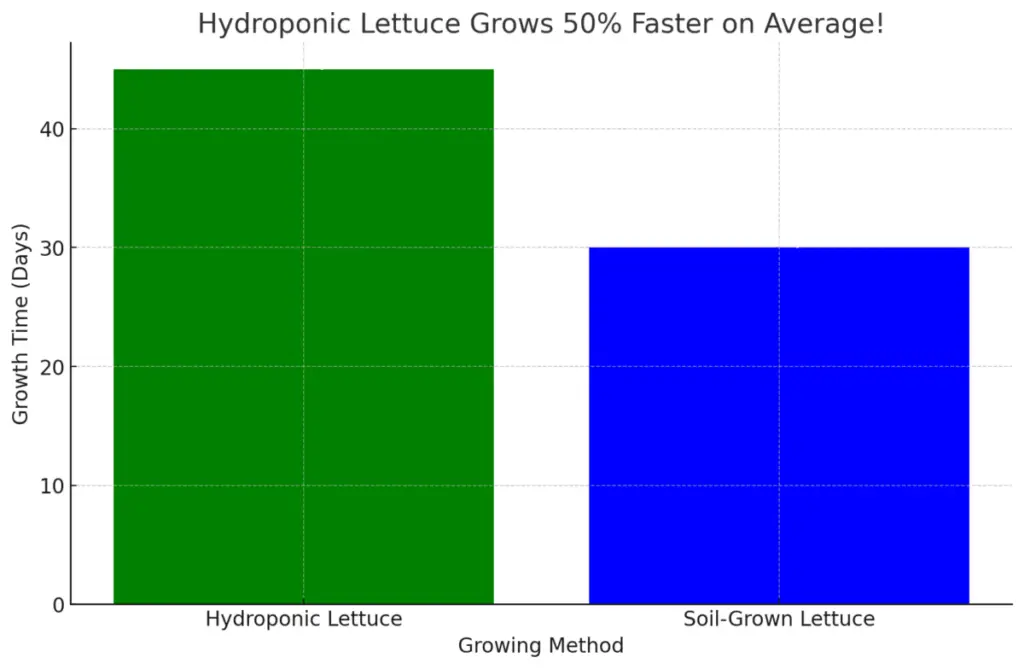
Data Comparison: Hydroponics vs. Soil Growth Rates
Key Takeaway: Hydroponics tends to cut growing time by 30-50%, which can be a game-changer if you’re looking to maximize yields quickly.
Taste and Nutrition: Do Hydroponic and Soil-Grown Plants Really Taste Different?
One of the biggest debates among gardeners is whether hydroponically grown produce tastes as good as soil-grown. The answer? It depends—but not in the way you might think.
Hydroponic Produce: Clean, Crisp, and Consistent
- Nutrient Control: Since you’re directly feeding plants the exact nutrients they need, hydroponic produce often has a consistent flavor profile.
- Water Quality Matters: Clean, mineral-rich water can enhance the taste, but poor water quality can dull flavors.
- Leafy Greens Shine: Crops like lettuce, basil, and spinach tend to taste exceptionally fresh and crisp when grown hydroponically.
Soil-Grown Produce: Rich, Earthy, and Complex
- Mineral Diversity: Soil naturally contains trace elements that can influence taste, giving some crops a more robust flavor.
- Sunlight and Soil Interaction: Sun-grown veggies develop slightly more complex sugars, which can enhance sweetness.
Tomatoes Taste the Difference: Many gardeners swear that soil-grown tomatoes are richer and more flavorful.
Cost Comparison: Which Method Hits Your Wallet Harder?
Gardening can be as cheap or as pricey as you make it. Let’s see how these two methods compare when it comes to your budget.
Initial Investment: Hydroponics Can Be Pricey Upfront
- System Setup: Depending on size and complexity, expect to spend between $300 to $800.
- Nutrient Solutions: Quality hydroponic nutrients can cost about $20-$50 per month.
- Lighting: If you’re growing indoors, you’ll also need grow lights, which can add another $100-$200 to your setup.
Soil Gardening: More Affordable Start, Ongoing Costs
- Basic Supplies: Seeds, soil, and tools typically cost around $50-$100.
- Amendments: Organic compost and fertilizers might add another $20-$40 per season.
- Maintenance: Less frequent need for nutrient replenishment compared to hydroponics.
Cost Comparison Table: Hydroponics vs. Soil
Key Takeaway: Hydroponics is a bigger upfront investment, but for high-yield and space-limited scenarios, it can pay off. Soil gardening remains the go-to for budget-conscious growers who have the space.
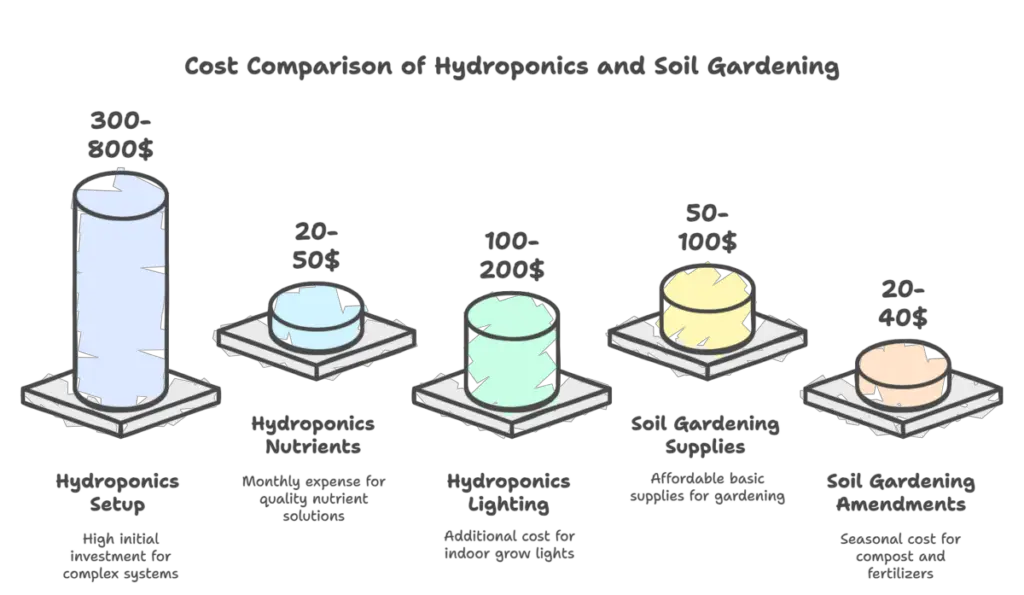
Environmental Impact: Which One Is More Sustainable?
As gardeners, we care about our plants and the planet. So, which method is kinder to the environment?
Hydroponics: Efficient but Energy-Intensive
- Water Usage: Hydroponics uses up to 90% less water than traditional soil gardening. Great for areas with water scarcity!
- Energy Consumption: Indoor hydroponic systems often rely on grow lights and pumps, which means more electricity use.
- Reduced Land Footprint: Vertical hydroponic systems make the most of small spaces, which is a win for urban settings.
Soil Gardening: Natural but Resource-Heavy
- Water Needs: Traditional gardens can be thirsty, especially in hot climates.
- Land Use: You’ll need ample space, which can be limiting for city dwellers.
Soil Degradation: Intensive gardening can lead to soil depletion and erosion if not managed properly.
Environmental Impact Summary: Hydroponics vs. Soil
Key Takeaway: If you’re aiming for a water-efficient, space-saving setup, hydroponics has the edge. But if you’re focused on a natural, low-energy approach, soil gardening still holds strong.
Which One Is Right for You? Practical Considerations
Okay, we’ve compared the numbers and the facts—but what really matters is what works for your lifestyle and space.
Choose Hydroponics If You:
- Have limited outdoor space (like a balcony or small apartment).
- Want faster growth and higher yields.
- Don’t mind the upfront investment and maintenance.
- Are comfortable with a more technical setup.
Choose Soil Gardening If You:
- Have access to a backyard or garden plot.
- Prefer a traditional gardening experience.
- Want to spend less on setup and maintenance.
Appreciate the natural, earthy feel of soil.
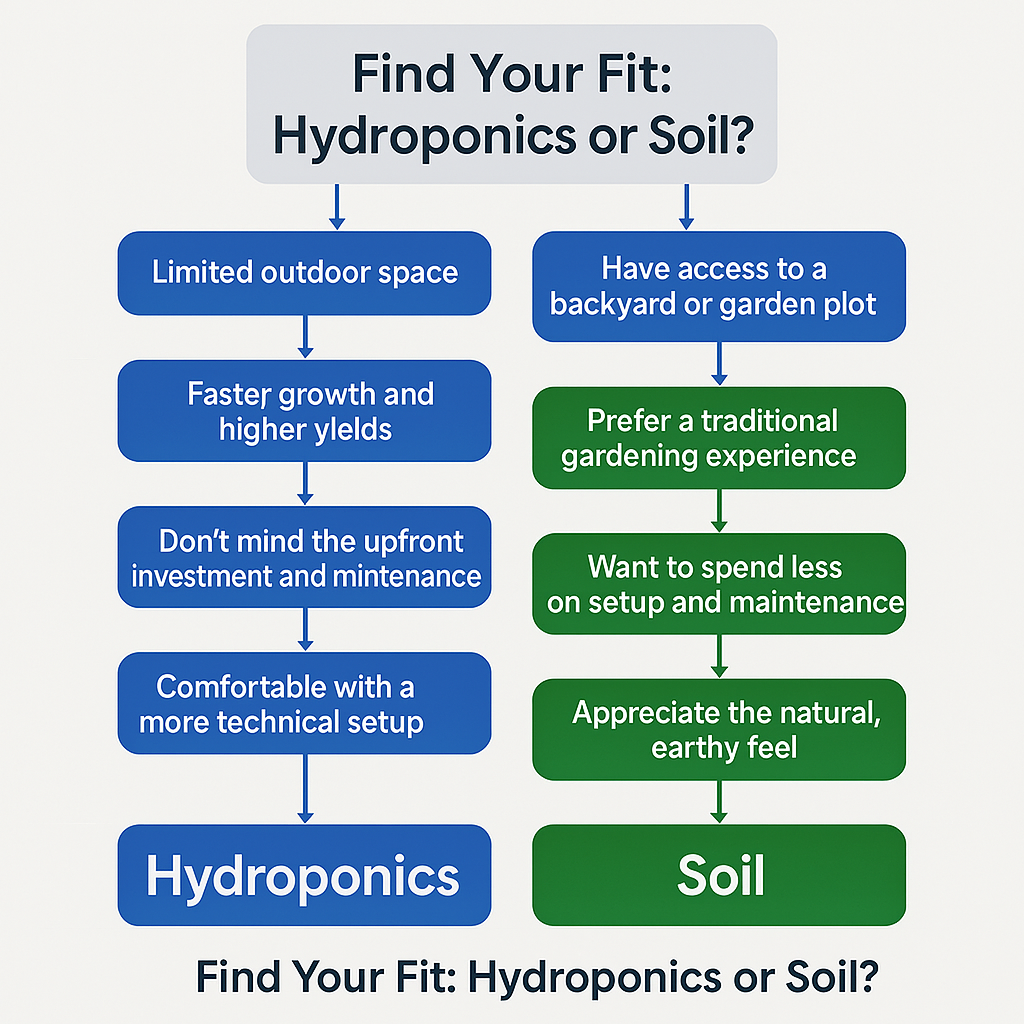
Case Studies: Real-World Success Stories with Hydroponics and Soil Gardening
Hearing about gardening methods in theory is one thing, but seeing how they play out in real life? That’s where it gets interesting! Let’s look at a few real-world examples where both hydroponic and soil gardening have made a difference.
Case Study 1: Urban Hydroponic Farm Thrives Indoors
Location: New York City
Setup: Vertical hydroponic system inside a small apartment
Crops: Lettuce, basil, cherry tomatoes
Outcome:
- This urban gardener transformed a tiny balcony into a year-round produce powerhouse using hydroponics.
- After the initial investment of around $500, the grower started seeing consistent harvests every 3 weeks.
- Thanks to the controlled environment, pests and diseases were almost non-existent, and the plants thrived even in winter.
- Key takeaway: Hydroponics allowed for fresh, homegrown veggies without outdoor space.
Case Study 2: Traditional Soil Garden Yields Flavorful, Heirloom Tomatoes
Location: Rural Midwest
Setup: Raised garden beds with compost-enriched soil
Crops: Heirloom tomatoes, squash, peppers
Outcome:
- The gardener started with a basic setup: wooden raised beds, compost from kitchen scraps, and heirloom seeds.
- With proper soil management and natural pest control, the tomatoes grew robust and flavorful, with a rich, earthy taste not commonly found in store-bought varieties.
- Total cost was around $150, including soil amendments and mulch.
- Key takeaway: Soil gardening proved ideal for flavor-rich crops, especially in areas with naturally fertile land.
Case Study 3: Community Hydroponic Garden Supports Local Food Bank
Location: Los Angeles, CA
Setup: Community-funded hydroponic greenhouse
Crops: Leafy greens, peppers, strawberries
Outcome:
- With funding from local businesses, a hydroponic greenhouse was built to support the community.
- Producing 30% more yield than traditional gardens of the same size, the setup consistently provided fresh greens to a local food bank.
- The system was maintained by volunteers, reducing labor costs while promoting community involvement.
- Key takeaway: Hydroponics can support community initiatives by maximizing space and productivity.
Case Study 4: Soil Gardening for Self-Sufficiency in a Suburban Backyard
Location: Portland, OR
Setup: Traditional in-ground garden with companion planting
Crops: Carrots, kale, beans, sunflowers
Outcome:
- Using companion planting techniques to naturally deter pests, the gardener created a self-sustaining backyard plot.
- Minimal input costs were balanced by using homemade compost and rainwater collection.
- The family of four enjoyed fresh produce throughout the growing season without relying on store-bought vegetables.
- Key takeaway: Soil gardening remains a practical and sustainable option for suburban households.
Lessons from the Case Studies
- Urban and Space-Limited Settings: Hydroponics shines, providing consistent yields with minimal space.
- Flavor and Heirloom Crops: Soil gardening often wins for taste, especially when the soil quality is rich and diverse.
- Community and Sustainability: Hydroponic setups can make a positive community impact, but traditional gardens excel in self-sufficiency.
- Budget Considerations: While hydroponics can be pricey upfront, community projects can offset costs, while soil gardens remain economical for personal use.
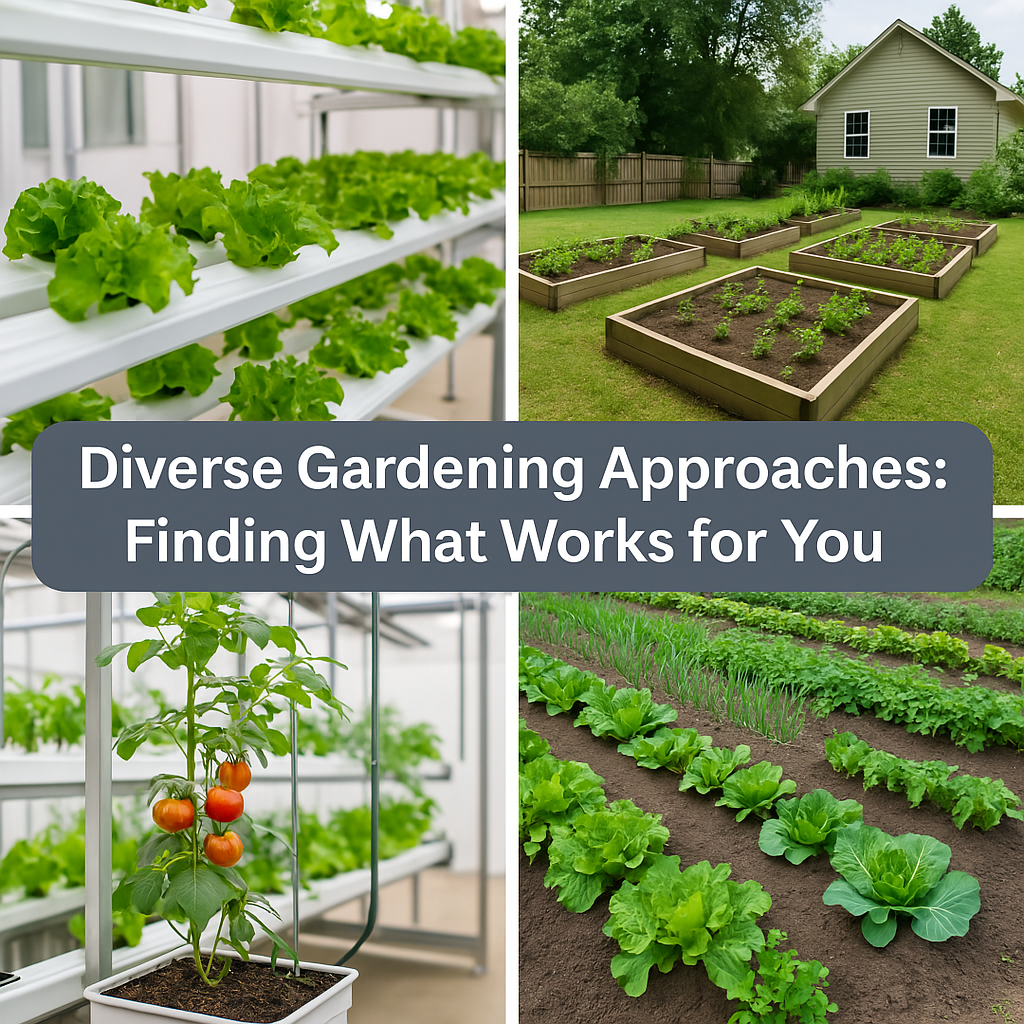
Frequently Asked Questions (FAQ)
Here are some of the most common questions people have when deciding between hydroponics and soil gardening. Hopefully, these answers will help you make the best choice for your gardening needs!
1. Can I combine hydroponic and soil gardening in one setup?
Absolutely! Many gardeners use a combination of both methods. For example, you might grow leafy greens hydroponically indoors while maintaining a traditional vegetable garden outside. This approach lets you maximize space and enjoy the benefits of both growing techniques. Just make sure to keep your hydroponic setup well-separated from soil to prevent contamination.
2. Is hydroponic gardening more prone to pests and diseases than soil gardening?
Not necessarily. In fact, hydroponic systems often have fewer pest problems since they are typically set up indoors or in controlled environments. Soil gardening, on the other hand, can attract a variety of pests and is more susceptible to soil-borne diseases. That said, hydroponic systems can still develop issues like root rot if the water quality or temperature is not properly managed.
3. How do I know if hydroponics is right for me?
Hydroponics might be the perfect choice if you:
- Lack outdoor gardening space (like living in an apartment)
- Want faster growth rates and higher yields
- Are willing to invest upfront in equipment
- Enjoy the technical side of gardening (monitoring pH, nutrient levels, etc.)
If you prefer a more traditional, hands-in-the-dirt experience and have enough yard space, soil gardening may be more your style.
4. Which method is better for growing root vegetables like carrots or potatoes?
Soil gardening is generally better for root vegetables because these crops need depth and support to develop properly. Hydroponic systems, especially those designed for leafy greens or vine crops, may not accommodate the growth habits of root veggies. However, some advanced hydroponic setups can handle compact root crops like radishes.
5. How can I keep costs low when starting a hydroponic garden?
Starting small is key! Instead of purchasing a full commercial setup, try a DIY hydroponic system using inexpensive materials like buckets or PVC pipes. Choose crops that thrive in hydroponics, like lettuce, spinach, or herbs, to see early successes without breaking the bank. Additionally, keep an eye out for secondhand equipment or discounted grow lights.
Final Thoughts: Growing Your Way
At the end of the day, there’s no one-size-fits-all answer. It’s all about finding what works for your situation, goals, and gardening vibe. Whether you’re growing a handful of herbs in a cozy apartment or planting rows of tomatoes in your backyard, both methods have their pros and cons.
So why not experiment? Start small, see what feels right, and enjoy the process. After all, gardening is about more than just results—it’s about finding joy in nurturing something from seed to harvest.
Additional Resources
Embarking on your gardening journey, whether through hydroponics or traditional soil methods, is both exciting and rewarding. To further enhance your knowledge and skills, here are some valuable resources:
Hydroponics Resources
- Hydroponics for Beginners: The Ultimate Guide
- Hydroponics 101: The Missing Manual
- Hydroponics vs. Soil: 7 Reasons Hydroponics Wins
Soil Gardening Resources
- How Do You Prepare Garden Soil for Planting?
- Practical Tips for Healthy Soil in a Home Garden
- Soil Basics 101

